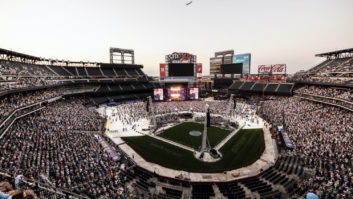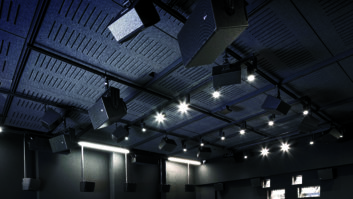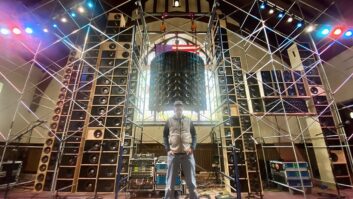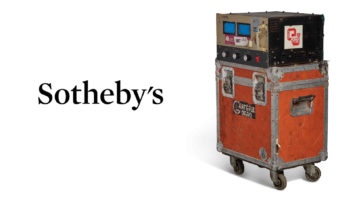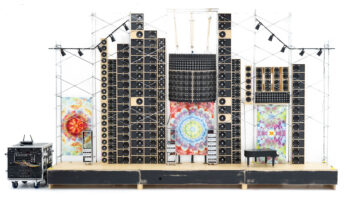The Grateful Dead’s final shows—the Fare Thee Well mini-tour—kicked off at Levi’s Stadium in Santa Clara, CA. All the final shows sported Meyer Sound-based audio systems.
New York, NY (July 7, 2015)—This past weekend saw the Grateful Dead close out its career at the 50-year mark with the last three of its final “Fare Thee Well” shows in Chicago. The short mini tour kicked off, however, at Levi’s Stadium in Santa Clara, CA, using a Meyer Sound Leo PA to create a quadraphonic surround setup for the 60,000 fans in attendance each night, and a nearly identical Leo system was used for the Chicago shows as well.

It all marked a milestone in the band’s decades-long association with Meyer Sound CEO John Meyer, a relationship spawned from a shared passion for audio experimentation and audience experience. The Grateful Dead’s original sound engineer, Owsley “Bear” Stanley, first tapped Meyer to create acoustic solutions for the legendary “Wall of Sound” system in the 1970s.
The Meyer Sound Leo system with its accompanying 1100-LFC low-frequency control element delivered an immersive fan experience in the large football stadium and supported an experimental segment devised by drummer/percussionist Mickey Hart. Using the Meyer Sound system to transmit ultra-low frequencies in surround sound, Hart probed how the brain perceived audible and below-audible rhythms.
“John Meyer’s 1100-LFC loudspeakers empower the rhythmic voice and enable percussionists to manifest new ideas,” said Mickey Hart. “They are sonic tools for reliably transmitting vibrations that affect neurologic function in a special way we are only beginning to understand, enabling us to explore healing properties embedded in low-frequency sound—a dream come true for us all.”
The Meyer Sound system comprised four front arrays of 17 Leo-M and three Mica line array loudspeakers each, with dual side columns of 14-each 1100-LFC low-frequency control elements and a center column of 22 700-HP subwoofers in an end-fire pattern. Side and offstage coverage was supplied by 32 Lyon and 32 Milo line array loudspeakers, respectively, with an additional 30 MICA loudspeakers providing behind-stage coverage.
Filling in the far ends of the stadiums were four delay towers with a total of 56 Milo loudspeakers and eight 700-HP subwoofers. Two additional towers of eight Lyon loudspeakers each faced the stage for quad surround effects, with six CQ-1 and four Lyon loudspeakers providing front fill. A Galileo Callisto loudspeaker management system handled drive and optimization, and 16 MJF-212A stage monitors provided onstage foldback.
Audio requirements for the shows were handled by Martinez, CA-based Pro Media / UltraSound, with system design accomplished by the company’s Derek Featherstone, vice president of touring and rental and the band’s FOH engineer since 2005. Additional equipment support for the five shows came from Blackhawk Audio, Rainbow Production Services, Show Systems, and Solotech.
“The LEO and 1100-LFC system can handle everything we put into it,” says Featherstone. “We are also very impressed with the quality control of the Meyer Sound self-powered equipment. Being able to acquire 650 loudspeakers from several different vendors located in multiple states, assemble the large system on site, and have it work seamlessly is no small feat.”
Matt Haasch, audio crew chief for Pro Media / Ultrasound adds: “I was impressed with how well the Leo system handled the physical acoustics of a big stadium. Coverage was smooth and practically seamless, with precise imaging for all seating areas.”
John Meyer’s work with the Grateful Dead extends to the mid-1970s when the band’s concerts were heard through McCune Sound Service’s JM-10 systems designed by Meyer. The relationship continued through the band’s last tour with Jerry Garcia in 1995, supported by Meyer Sound MSL-10 loudspeakers. Meyer Sound systems have been a staple for tours of reunion and spin-off bands during the interim, including the 2005 and 2009 tours equipped with a Meyer Sound Milo system when the core members were known as The Dead. In 2011, the band’s Bob Weir installed a Meyer Sound Constellation acoustic system in his Tamalpais Research Institute (TRI).
Meyer Sound Laboratories
www.meyersound.com
